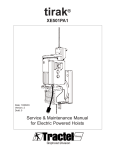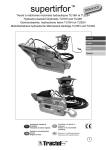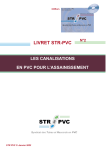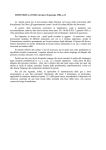Download TU17 & 28 service manual.qxd
Transcript
Griphoist-Tirfor TU-17/TU-8 & TU-28/TU-16 Date: 04/05/04 Version:2a Service and Maintenence Manual Table of Contents UL Listing Card P. 3 Tools required P. 4 General Inspection P. 4 Disassemble TU-17/TU-8 P. 5 Disassemble the two jaw blocks P. 8 Reassemble P. 10 Front Jaw Assembly P. 12 TU-17/TU-8 & TU-28/TU-16 Physical Differences P. 19 TU-17/TU-8 Dimensions P. 20 TU-28/TU-16 Dimensions P. 21 Hydraulic Powered Units P. 22 TU-28H vs. TU-28 Comparison P. 23 Appendix A (exploded view for TU-17/TU-8 & TU-28/TU-16) P. 24 Appendix B (Jaw Inspection) P. 28 2 UL Listing Card Northbrook, Ilinois (847) 272- 8800 Melville, New York (631) 271-6200 Santa Clara, California (408) 985-2400 Research Triangle Park, North Carolina (919) 549-1400 Camas, Washington (360) 817-5500 TRACTEL INC GRIPHOIST DIV 110 SHAWMUT RD PO BOX 188 CANTON, MA 02021 TUFV Equiptment, Scaffolding April 18, 2002 TRACTEL INC GRIPHOIST DIV 110 SHAWMUT RD PO BOX 188, CANTON MA 02021 SA4785 Electric scaffold hoists, Models ETH-32L, XE301P, maximum load 700 lbs: Models ETH35C, ETH35C3, ETH35X, LE500P, LE501P, TE401P, -401PA, XE500P, -501P, -501PA, maximum load 1000lbs; Models TE1000P, -1001P, -1001PA, XE501PO, XE700P, -701P, XE720P, XE721P, maximum load 1500lbs; Models TE1020P, -1021P, -1021PA, maximum load 2000 lbs; Model XE1020P, maximum load 2400 lbs; Model XE2050P, maximum load 4400 lbs. Manually operated scaffold hoists, Model TMS-600, maximum load 1320 lbs; Model TU-17, maximum load 1500 lbs; Model TU-28, maximum load 3000 lbs; Model TU-32, maximum load 6000 lbs; Model 408, maximum load 880 lbs. Pneumatic scaffold hoists, Models ATH32L, -32LB, XA300P, -300PB, maximum load 700 lbs; Models ATH35C ATH35X, -35XB, LA500P, XA500P, -500PB, maximum load 1000 lbs; Models XA700P, -700PB, XA720PB, maximum load 1500 lbs; Model XA1030PO, maximum load 1850 lbs; Model TA1020P, maximum load 2000 lbs; Model XA1020P, maximum load 2400 lbs; Model XA2050P, maximum load 4400 lbs; Model XA2650P, maximum load 5300 lbs. Independent secondary brakes, Model BS15.301, maximum load 1500 lbs; Model BS20.301, maximum load 3000 lbs; Model BS35.30, maximum load 6000 lbs. Modular work platform, “Modular Staging”, 2 to 12 m, rated 750 lbs; Models KD01, MP03, 2 to 18m, rated 750 to 1500 lbs; “PFD”, 2 to 15m, load 6000 lbs. Work Cages, Model PMR0700D, PMR0701D, VSMV-PMR0710D, rated 1000 lbs; Model WC01, rated 400 lbs. This equipment consists of separate parts inspected at the factory by Underwriters Laboratories Inc. and is intended for use in complete complete installations. Installations are not inspected by Underwriters Laboratories Inc. but should be made in accordance with requirements of authorities having jurisdiction. LOOK FOR CLASSIFICATION MARK ON PRODUCT 3 General Inspection Tools required Hammer Screwdriver (Flat head) Gear puller Pliers Wrenchs -10mm (TU-17 / TU-8) -13mm (TU-28 / TU-16) 2 nails (for jaw spring compression) General purpose grease Check for casing deformation or damage as shown above. Severe deformity needs casing replacement. Small dents can be hammered flat on an anvil. 4 Disassemble TU-17 / TU-8 Use a gear puller to remove power stroke lever and shear pins. Remove the handle and aluminum shear pins. (2 shear pins for TU-17, 3 shear pins from TU-28) If shear pins are broken, hoist has been overloaded. If shear pins have been replaced by steel fasteners, screws or welded the crankshaft / power stroke lever assembly must be replaced. Place Tirfor on vice for easier removal of casing screws. 2 sets of spare shear pins are found in the power stroke lever under a plastic cap. If missing replace them. Check that mushroom capped rivet is in place. It holds the telescopic handle in place. 5 Remove casing screws. 10mm wrench TU-17 / TU-8 Check for wear or any loose parts (snap rings) inside casing cover. Check that both casing bushings are in place and in good condition. No splits, etc. Remove casing cover once casing screws are removed. 6 Check for roller damage. If axle has punched out hole in center of roller replace it. Check for bent safety latch on hook. Repair or replace as necessary. check latching function. Make sure that the hook is not opened due to a tip load. Broken roller (TU-17/TU-8) as shown above need to be replaced. Use pliers to adjust bent safety latch. Side plates should be parallel. Check that clutch pusher has not been mushroomed by hammering. This shows that user tried to move it with anchor hook extended. 7 Disassemble the two jaw blocks Remove pin snap from reversing lever pin (Position. 39) and remove reversing lever connecting rod from assembly. Remove pin snap ring (5 mm) from upper pin of reversing lever (Position. 040) and clutch pin (Position. 041) Push pins through reversing lever and dissassemble reversing lever connecting rod Remove pin snap from crankshaft connecting rod (Position. 919) and remove crankshaft power stroke lever. Check that nylon bushings are in place and not broken. 8 Warning: Never remove jaw pins until springs has been compressed and nail is placed through hole in shaft to prevent it from flying upon disassembly. Compress the springs and place a nail in jaw spring shaft before removing spring from jaw assembly. Inspect jaw wear and replace when nessasary. (see appendix B for jaw inspection) Dissassemble front jaw the same way. Thoroughly clean and inspect all parts before reassemble. New grease must be applied for reassembly. Warning! Do not use any grease with graphite or molydisulphide. These can cause slippage between the wire rope and jaws. Remove pin snap ring from pin (Position. 032 & Position. 034) and dissassemble jaw assembly 9 Reassemble Assemble jaw as shown above. (Refer to exploded view in appendix A for assembly) Generously grease each part and start assembly by laying down jaw actuating cam and free cam (Position. 14 & Position. 15) Note: Make sure to apply extreme pressure grease to the jaw keys. Lack of lubrication on the S shaped jaw keys can cause the jaws to stick and “pumping occurs where the rope does not advance through the machine when operating. 10 Slide rear jaw connecting plate over the jaw assembly. Be careful that the S shaped jaw keys do not fall out. Place spring in position, apply pressure to aw cam to compress the spring slightly and remove the nail. Finalize assembly by placing pin snap back on pin and center the axle for the rollers. Place 4 flat washers and 1 spacer in to assembly for complete rear jaw assembly. (Refer to appendix A for exploded assembly view) 11 Front jaw assembly Grease nylon roller and place roller with washers on to jaw assembly pin. (Position. 034) Generously grease each part and assemble jaw the same way as rear jaw. Place crankshaft on to rear jaw connecting plates. Make sure that the stop pin is recessed in the side plate slot. 12 Place bushing between free cams. Place jaw assembly into front jaw assembly plate. Place 4 flat washer and pin in alignment. Once assembly finalized, remove nail and secure pin in assembly by pin snap ring. 13 Grease roller and place roller on jaw assembly pin on guide roller. (Position. 034) Secure crankshaft connecting pin with pin snap ring. Connect front and rear jaw with crankshaft. (Position. 919) Start reversing lever assembly by fasten lever in place with reversing lever pin (Position. 039) 14 Place spacer and fasten reversing lever connecting rods with reversing lever pin. (Position. 039) Assemble clutch actuating lever sub assembely to reversing lever. Secure assembly with pin and pin snap ring. Assemble reversing connecting rods (Position.021) to Reversing lever (Position. 903) 15 Grease right hand casing and check for casing deformity, nylon bushing, and bearing wear. Make sure casing spacer thread (Position. 045) is fastened before placing the jaws into cover. Place jaws into casing and tuck the spring on clutch actuating lever in to casing. Use a vise grip to hold clutch actuating lever in place. 16 Assemble clutch lock pusher into casing. Place left hand casing over assembly. Place rope entry in position. Start tightening all casing screws. Place anchoring hook in position. 17 Fasten through casing screw. Place hoist on vise for easier assembly. Grease shaft and install power stroke lever on crankshaft. Secure it with 2 new shear pins for TU-17/TU-8 and 3 for TU-28/TU-18. Do not reuse shear pins. Make sure casing flange is in place for fastening 18 TU-17 / TU-8 & TU-28/TU-16 Physical Differences TU-28 appears to look like the TU-17 with the exception in size and several minor differences which are described below. The Hook TU-28 shown above has a loose casing strengthener to reinforce the area around the hook. TU-17 shown above does not have a loose casing strengthener, but has reinforcement in the hook area of the casing. The clutch lock pusher with spring TU-28’s clutch lock pusher with. TU-17’s clutch lock pusher with spring. 19 TU-28 has a carrying handle. TU-17 does not have carrying handl. TU-28’s crankshaft w/ power stroke lever has 3 aluminum shear pins. TU-17’s crankshaft w/ power stroke lever has 2 aluminum shear pins. TU-17 Dimensions Telescopic Control Lever 20 TU-28 Dimensions Telescope Control Lever 21 Hydraulic Powered Units The hydraulic powered Tirfors are special mahcines that is powered by a self reciprocating hydraulic cylinder. Since fatique of the operator is not a factor, these machines are typically used for heavy loads over a longer distance. For extra durability and more severe service, the hydraulic machines have bearings in place of bushings and heat treated components. 22 TU-28H vs. TU-28 Comparison TU-28H is a hydraulic powered device. It differs from a regular TU-28 in the components used. Below are illustrations of the differences. Top crankshaft TU-28H has reinforced needle bearing contact surface vs. lower crankshaft that has no reinforced contact surface with casing. Power stroke lever shown above clearly demonstrates the difference between a hydraulic unit which is on the left and a standard unit on the right. Note: Shear pins for hydrolic units are steel compare to aluminum for regular hand operated unit. Hydrolic unit has tapered hook base shown on left vs. ridgid base on a regular hand operated unit shown on right. Crankshaft for hydraulic units has needle bearings demonstrated above on the left vs. standard hand operated unit which does not have bearing shown on above right. Left picture shows reinforced TU-28H casing with needle bearing vs. right picture that has nylon bushing for standard hand operated unit. Both front and rear jaws for hydraulic unit has red paint indicating extra hardening shown on above left. 23 Exploded view for TU-17 Appendix A 24 25 TU-28 exploded view 26 27 Appendix B Jaw inspection The Wear on the jaws of the tirfor hoists is generally very small. It is nevertheless recommended to check periodically the wear when inspecting and repairing the machines. This checking can be made on mounted jaws. 1) Introduce the measuring rod (see table for diameter according to model) between both jaws; 2) Place a square under jaw assembly pins: a) if the hole of reversing lever pin is still partially covered by the square, the jaws are OK; b) if this hole is completely uncovered, the jaws are worn and must be replaced. In this case, better check also the other wear parts mentioned in the list hereunder and eventually replace them at the same time. 28
































